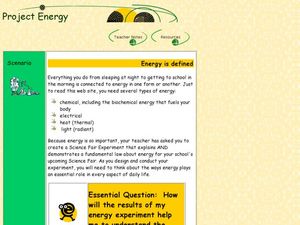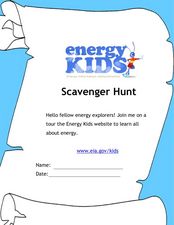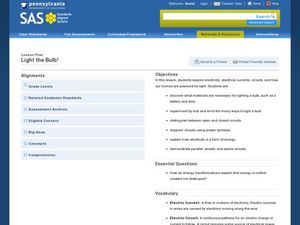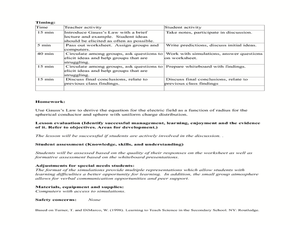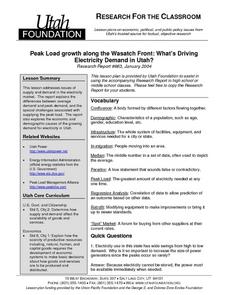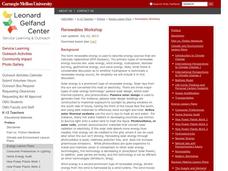Curated OER
Introduction to Magnets
Learners explore magnetism, electromagnetism, and static electricity through a series of activities and experiments. In this magnets lesson, students use magnets to observe the forces of attraction and repulsion between different poles....
Curated OER
Project Energy
Students explore multiple types of energy. In this energy instructional activity, students prepare a science fair project through completing a WebQuest. Students investigate radiant, thermal, and biochemical energy.
Curated OER
Energy Generating a Culture: Early American Coal Miners and Coal Mining Culture
Students calculate how much coal they use based on their electric power usage. In this environmental science lesson plan, students trace the history of coal mining in US. They write a letter to USPS to encourage them to create coal...
Curated OER
Operating Kitchen Equipment
Students spend this lesson discovering how electricity makes the appliances in their kitchen operate. In groups, they explain how energy is being converted in a microwave oven and practice giving others directions to how to use them. ...
Curated OER
Bolts Out of the Blue
Students research different types of lightning patterns and compare their origins to an experiment on static electricity. They research different types of lightning, and explain how different light patterns result from those charges.
Curated OER
Energy Adventure Scavenger Hunt
Students complete a scavenger hunt. In this energy lesson, students use various Internet websites to explore forms of energy, non-renewable sources, renewable sources, electricity, uses of energy and energy efficiency.
Pennsylvania Department of Education
Light the Bulb!
Third graders investigate electrical circuits and how light bulbs are powered. In this electricity and power activity, 3rd graders study the vocabulary necessary which includes the different types of circuits, electrical currents, and...
Curated OER
Galvanic Reactions
Students create a battery using pennies. In this galvanic reactions lesson plan, students use pennies, a washer, salt water, wires, tape and a paper towel to create a battery. They use a voltmeter to record the voltage in their battery...
Curated OER
Liquid Conductors
Students identify liquids as conductors. In this circuits lesson plan, students build a circuit, then use various liquids to complete the circuit, and determine which liquids successfully conduct electricity.
Curated OER
Dirty Air And Bright Lights
Students are asked to think about their use of electricity, particularly around the holidays, and how it affects their quality of life and the lives of all of us. They explore the issue by tracing the connections and discussing how and...
Curated OER
Stormy Weather
Students conduct various experiments to explore the concepts that static electricity is the cause of lightning.
Curated OER
REDOX Lab
Students produce copper metal by electrolysis. In this REDOX lesson plan, students use a copper (II) chloride solution and a 9 volt battery to produce copper metal through an electrolysis reaction. Students make observations and take...
Curated OER
Sustainable Island Development
Students explain how the basic human needs of a large group of people can be met. They describe and evaluate alternative methods for providing water and food, producing electricity, handling wastes, and transporting goods and people....
Curated OER
The Affect of Water Temperature on Living Organisms
Students examine the environmental impact of global warming. In this environmental science lesson, students design and conduct an experiment about the effect of temperature on paramecia. They write a lab report about their experiment.
Curated OER
Gauss' Law
Learners derive the equation of Gauss's law. In this physics instructional activity, students investigate the factors affecting the strength of the electric field. They perform simulation on Gauss's law.
Curated OER
Electric Gelatin
Students complete an experiment about static electricity. They are provided with a small plate that has gelatin and then given a small balloon. Students put the balloon above the gelatin and observe what happens, and then slowly raise...
Curated OER
Powered Up About Electricity!
Students study the process of turning coal into electricity. In this electricity lesson, students are guided by their teacher through the steps required to turn coal into electricity. Students complete a worksheet answering questions...
Curated OER
Peak Load Growth Along the Wasatch Front: What's Driving Electricity Demand in Utah?
Learners study how electricity is used in Utah. They create an advertising plan to educate consumers about peak cycles and energy costs for the cycling service of electricity. They present their advertising plan to the class for...
Curated OER
Electricity Serves Us
Second graders identify sources of energy that produce electricity and serves our community.
Curated OER
Electrical Circuits - Current & Voltage in Series Circuits
Learners investigate the relationship between current and voltage in a series circuit. In this physics lesson, students measure the current across each light bulb. They predict what happens to the circuit if one bulb is blows out.
Curated OER
Electricity – Ohm’s Law
Students investigate the relationship between voltage and current. In this physics lesson, students observe and collect data from the experiment. They graph the result and share them to class.
Curated OER
Lesson 2 of 5 - Energy
Young scholars complete an energy analysis for the No Impact Man project. In this environment and energy lesson plan, students review the project by visiting the given website and discuss the issue of electricity in the project. Young...
Carnegie Mellon University
Renewables Workshop
Youngsters examine resource maps to find out which states are using solar and wind power and discuss as a class various other renewable energy sources. They use a provided data table to record pros and cons to each technology, build and...
Virginia Department of Education
Acids and Bases
What did one titration say to the other titration? We should meet at the end point! Young chemists perform four experiments: dilute solution, neutralization, titration, and figuring pH/pOH.



